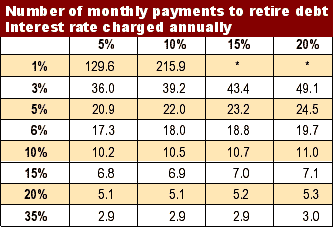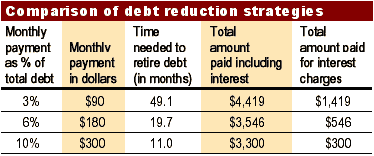
HOT TOPICS LIST
- Strategies
- Stocks
- Buy
- Investing
- Brokers
- Psychology
- Interviews
- Accumulate
- Sell
- Hold
- Spotlight
- Websites
- Candlestick Corner
- Gold & Metals
- Options Trading
LIST OF TOPICS
MONEY MANAGEMENT
How Soon Is Now?
03/01/01 02:08:50 PM PSTby David Penn
Up to your ears in credit debt? Try timing your debt down to size.
| For many young people (and for many who are not so young), finding the money to set aside for an investment program can mean choosing between paying off current debts and laying the groundwork for a financially sound future. And depending on who you ask, you are likely to get conflicting answers as to which is more important: getting out of debt or getting into investing. Sure, getting out of debt -- or at least getting debts down to a manageable level -- is an admirable and important goal. This is particularly true if you have debts for which you can only make minimum payments, as is often the case with credit card debt. As you may know from months or years of whacking away at redwood-sized credit debts, minimum payments barely take the bark off the debt tree. Moreover, paying off a debt with an interest of 20% -- typical of many credit cards -- is the financial equivalent of an investment yielding 20% -- not bad for a fistful of plastic. If you can't decide which to do first, perhaps you can do both at the same time. Unfortunately, the problem with this approach is that often, both needs tend to be undersatisfied: minimum payments toward your credit debts become the rule, and the true potential of your investments is limited by the relatively small amount of cash you have to put to work in the markets. PUTTING TIME ON YOUR SIDE One of the most important things in investing is the concept of time horizon. How much money do you need/want and when do you need/want it? Not only does this help you decide how to invest (stocks, mutual funds, bonds, and so forth), but this approach also helps you better understand the reason why you are investing in the first place. Do your goals include long-term capital appreciation for retirement, a European vacation two years from now, a college education for your preschool children? The list goes on. The good news is that a similar approach to time horizon can also help you pay down your debts. Rather than flinging money at your debts as fast as you can, you can plot a time horizon that will let you know just how long it will take to pay off your debts. This information can be extremely helpful in planning budgets, determining both how much money you can devote to debt reduction and how long your debt-reduction project will take. Figure 1 is essentially an amortization table like those used by bankers, accountants, and others in the financial industry for whom debt and debt reduction is serious, everyday business. The left-hand column represents the regular debt payment as a percentage of the total debt. The asterisk (*) represents what is known as negative amortization. This means that a payment of the stated size is insufficient to repay even the interest on the debt, meaning the total debt actually increases each month instead of falling.
If four years sounds like a long time, you're right. But the 3% rate is a fairly common minimum payment for many credit cards. As you can see, minimum payments can turn into years of debt service and hundreds of additional dollars in interest. All this assumes, of course, that no additional charges are added to the debt, making your $90-a-month payment reflect a lower percentage of the total debt, and that the percentage size of your monthly payment is not increased. How much less time would it take if you were to double your monthly payment? A $180 monthly payment would represent 6% of the total outstanding debt. At 20% annual interest, it would take you 19.7 months, or a little over a year and a half to retire the debt. Let's compare the payment approaches. An even more aggressive debt retirement strategy -- monthly payments representing 10% of the total debt -- has been added for illustrative purposes. In Figure 2, the same $3,000 debt with a 20% interest rate is used. A less-aggressive debt retirement strategy such as the minimum-payment 3% approach not only takes two and a half times longer than a strategy that involves paying 6% of the total debt each month, but also means paying more than two and a half times the interest paid in the 6% plan. Whereas the 6% plan results in paying effectively an 18% premium on the $3,000 debt, the 3% approach results in a whopping 47% premium.
SIZING UP YOUR OPTIONS If nothing else, comparing payment amounts to interest rates and debt sizes should suggest one thing: avoid paying minimum amounts. To be sure, there are often times when minimum amounts are the only amounts that can be paid without extreme sacrifice. It is certainly better to pay a minimum amount than to let a regular debt payment go by late, or worse, unpaid. But it is important to remember that a minimum payment is just that. More than being the lowest amount that a creditor will accept, the "minimum" often means that it is the minimum amount necessary to avoid falling into the diminishing returns of negative amortization, in which you are steadily losing ground instead of gaining. If you are really trying to pay down your debts instead of merely treading water, minimum payments are not for you. Knowing how long a particular debt will take to pay off is a tremendous help for budget planning. While many credit card debts are run up to pay off unexpected school, medical (or veterinary), or family emergencies, a great many credit card debts are simply the result of poor planning. The ability to establish a regular schedule of debt repayment is one of the most important steps toward building a workable budget. Doing so will allow you to effectively increase your income by saving money, paying down debts, and providing enough money for you to invest with confidence. This way, you will not have to liquidate your investments to pay off other financial obligations. Another benefit of putting your debts on a retirement schedule is that it can help fend off overly aggressive creditors. While there may be little room for negotiation with large outstanding debts or debts with a flawed history of repayment, it is true that creditors are generally much easier to deal with when they can be provided with a detailed repayment plan. This is especially true if the repayment plan schedules payments significantly greater than the minimums necessary to avoid negative amortization. Telling a creditor "I'll be paying twice the minimum payment for the next year and a half to retire this debt" is far better than pleading to send "as much as I can as fast as I can" -- even if you really mean it. Perhaps the greatest benefit, however, is in seeing light at the end of what can seem like an endlessly dark tunnel of debt. While we are all individually responsible for the debts we incur, many of us grew up in a culture that encouraged "consumerism" and boasted of opportunities to "shop 'til you drop." In fact, credit card companies continue to send credit cards to people already encumbered with an uncomfortable debtload. If you have taken advantage of credit in the past and now find credit card payments taking advantage of you, remember there are ways to regain the upper hand. Find out how much you owe. Find out what interest rate you are being charged. Decide how soon you want to be debt-free. And act now. David Penn can be reached at DPenn@Traders.com. |
Technical Writer for Technical Analysis of STOCKS & COMMODITIES magazine, Working-Money.com, and Traders.com Advantage.
| Title: | Traders.com Technical Writer |
| Company: | Technical Analysis, Inc. |
| Address: | 4757 California Avenue SW |
| Seattle, WA 98116 | |
| Phone # for sales: | 206 938 0570 |
| Fax: | 206 938 1307 |
| Website: | www.traders.com |
| E-mail address: | DPenn@traders.com |
Traders' Resource Links | |
| Charting the Stock Market: The Wyckoff Method -- Books | |
| Working-Money.com -- Online Trading Services | |
| Traders.com Advantage -- Online Trading Services | |
| Technical Analysis of Stocks & Commodities -- Publications and Newsletters | |
| Working Money, at Working-Money.com -- Publications and Newsletters | |
| Traders.com Advantage -- Publications and Newsletters | |
| Professional Traders Starter Kit -- Software | |
PRINT THIS ARTICLE

|

Request Information From Our Sponsors
- StockCharts.com, Inc.
- Candle Patterns
- Candlestick Charting Explained
- Intermarket Technical Analysis
- John Murphy on Chart Analysis
- John Murphy's Chart Pattern Recognition
- John Murphy's Market Message
- MurphyExplainsMarketAnalysis-Intermarket Analysis
- MurphyExplainsMarketAnalysis-Visual Analysis
- StockCharts.com
- Technical Analysis of the Financial Markets
- The Visual Investor
- VectorVest, Inc.
- Executive Premier Workshop
- One-Day Options Course
- OptionsPro
- Retirement Income Workshop
- Sure-Fire Trading Systems (VectorVest, Inc.)
- Trading as a Business Workshop
- VectorVest 7 EOD
- VectorVest 7 RealTime/IntraDay
- VectorVest AutoTester
- VectorVest Educational Services
- VectorVest OnLine
- VectorVest Options Analyzer
- VectorVest ProGraphics v6.0
- VectorVest ProTrader 7
- VectorVest RealTime Derby Tool
- VectorVest Simulator
- VectorVest Variator
- VectorVest Watchdog


